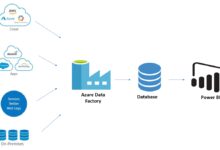Azure Cost Calculator: 7 Powerful Tips to Master Cloud Budgeting
Want to predict your cloud spending with precision? The Azure Cost Calculator is your ultimate tool for estimating, planning, and optimizing Microsoft Azure expenses—without any surprises.
What Is the Azure Cost Calculator?

The Azure Cost Calculator, officially known as the Azure Pricing Calculator, is a free online tool provided by Microsoft to help businesses, developers, and IT teams estimate the monthly cost of using Azure services. Whether you’re launching a new application, migrating from on-premises infrastructure, or scaling existing workloads, this tool gives you a clear financial forecast before you deploy a single resource.
How the Azure Cost Calculator Works
At its core, the Azure Cost Calculator operates on a simple principle: you select the Azure services you plan to use, configure them according to your expected usage, and the tool calculates an estimated monthly cost. It supports a wide range of services including virtual machines, storage, networking, databases, AI, and more.
- Users add services to a customizable estimate.
- Each service can be configured with region, instance size, usage hours, and data transfer volume.
- The calculator updates the total cost in real time.
This dynamic interface allows for rapid scenario testing—perfect for comparing different architectures or deployment strategies.
Why It’s Different From TCO Calculator
It’s important to distinguish the Azure Cost Calculator from the Azure Total Cost of Ownership (TCO) Calculator. While both are financial planning tools, they serve different purposes:
- Azure Cost Calculator: Focuses on estimating the direct cost of Azure services based on configuration.
- TCO Calculator: Compares the long-term cost of running workloads on-premises versus moving them to Azure, factoring in hardware, maintenance, power, and labor.
“The Azure Cost Calculator is about ‘how much will I pay for Azure?’ while the TCO Calculator answers ‘is moving to Azure cheaper than my current setup?’.”
Why You Need the Azure Cost Calculator
In today’s cloud-first world, cost unpredictability is one of the biggest risks organizations face. Without proper planning, cloud bills can spiral out of control. The Azure Cost Calculator empowers teams to take control of their budgets from day one.
Prevent Cost Overruns Before Deployment
One of the most powerful benefits of the Azure Cost Calculator is its ability to prevent budget overruns before any resources are provisioned. By modeling your environment in the calculator, you can identify expensive configurations early—like over-provisioned VMs or unnecessary data transfers—and adjust accordingly.
- Simulate production environments without spending a dime.
- Compare high-availability setups vs. single-instance deployments.
- Test the financial impact of auto-scaling policies.
This proactive approach saves both time and money, especially in large-scale migrations.
Support for Multi-Service Architecture Planning
Modern applications rarely rely on a single service. They often combine compute, storage, databases, content delivery networks, and monitoring tools. The Azure Cost Calculator allows you to build a complete architecture and see how each component contributes to the total cost.
- Add multiple virtual machines across regions.
- Include Azure SQL Database, Blob Storage, and Application Gateway.
- Factor in data egress fees, which are often overlooked but can be significant.
This holistic view is essential for accurate budgeting and stakeholder reporting.
Step-by-Step Guide to Using the Azure Cost Calculator
Using the Azure Cost Calculator is straightforward, but mastering it requires attention to detail. Follow this step-by-step process to get the most accurate estimates.
Step 1: Access the Calculator and Start a New Estimate
Visit azure.microsoft.com/pricing/calculator and click “Create a new estimate.” You don’t need an Azure account to use the tool, making it accessible to anyone involved in planning.
- You can save your estimate by signing in with a Microsoft account.
- Saved estimates can be shared with team members via link.
- Multiple estimates can be created for different projects or scenarios.
Step 2: Add and Configure Azure Services
Click “Add” to browse available services. You can search by name (e.g., “Virtual Machines”) or category (e.g., “Compute”). Once added, configure each service with realistic parameters:
- Region: Pricing varies by region. Choose the one closest to your users.
- Instance Size: For VMs, select from predefined sizes (e.g., D2s v3, E4as v4).
- Usage Hours: Specify if the resource runs 24/7 or only during business hours.
- Data Transfer: Estimate inbound and outbound data in GB.
For example, adding an Azure Virtual Machine lets you choose between Linux and Windows, enable backup, and even include managed disks—all of which affect the final price.
Step 3: Review, Export, and Share Your Estimate
Once all services are added, the calculator displays a summary with:
- Total estimated monthly cost.
- Breakdown by service category (Compute, Storage, Networking, etc.).
- Option to view annual cost.
You can export the estimate as a CSV file for budget proposals or share it directly with stakeholders. This transparency fosters better decision-making across teams.
Advanced Features of the Azure Cost Calculator
Beyond basic cost estimation, the Azure Cost Calculator offers several advanced features that make it indispensable for enterprise planning and financial governance.
Support for Reserved Instances and Savings Plans
The calculator includes options to model cost savings from Azure Reserved VM Instances and Azure Savings Plans. These are commitment-based pricing models that can reduce costs by up to 72% compared to pay-as-you-go rates.
- You can toggle between “Pay as you go” and “Reserved” pricing.
- Select reservation terms: 1-year or 3-year.
- See the estimated savings and break-even point.
This feature is crucial for long-term projects where workloads are predictable and stable.
Integration With Azure Advisor and Cost Management
While the Azure Cost Calculator is a pre-deployment tool, it complements Azure’s post-deployment cost management suite. Once resources are live, you can use Azure Cost Management + Billing and Azure Advisor to monitor actual spending and receive optimization recommendations.
- Advisor identifies underutilized VMs and suggests right-sizing.
- Cost Management provides dashboards, budgets, and alerts.
- Data from the calculator can be used as a baseline for comparison.
“The Azure Cost Calculator sets the budget; Azure Cost Management helps you stay within it.”
Common Mistakes When Using the Azure Cost Calculator
Even experienced users can make errors that lead to inaccurate cost projections. Avoiding these pitfalls ensures your estimates are reliable and actionable.
Ignoring Data Transfer and Egress Fees
One of the most common oversights is underestimating data transfer costs. While inbound data is usually free, outbound data (egress) is charged—especially when transferring data out of Azure to the internet or between regions.
- Egress costs vary by destination region and volume.
- High-traffic websites or APIs can incur significant egress fees.
- Always model worst-case scenarios for data transfer.
For example, transferring 10 TB of data from Azure US East to the internet could cost over $500/month—money not accounted for if ignored in the calculator.
Over-Provisioning Virtual Machines
It’s tempting to choose large VM sizes “just to be safe,” but this habit inflates costs unnecessarily. The Azure Cost Calculator allows you to test different VM sizes and see the price difference instantly.
- A D8s v3 VM can cost 4x more than a D2s v3.
- Use performance benchmarks or Azure Advisor recommendations to right-size.
- Consider autoscaling instead of over-provisioning.
By testing smaller instances in the calculator, you can find the optimal balance between performance and cost.
How the Azure Cost Calculator Compares to Other Tools
While Microsoft’s tool is robust, it’s worth understanding how it stacks up against alternatives—both within Azure and from other cloud providers.
Azure Cost Calculator vs. AWS Pricing Calculator
Amazon Web Services offers a similar tool: the AWS Pricing Calculator. Both tools allow detailed service configuration and real-time cost estimation. However, there are key differences:
- Azure’s interface is often praised for being more intuitive and visually clean.
- AWS calculator offers deeper integration with specific services like Lambda and DynamoDB.
- Azure includes Savings Plans directly in the calculator; AWS separates Reserved Instance modeling.
For organizations using both clouds, familiarity with both tools is essential for accurate cross-platform comparisons.
Azure Cost Calculator vs. Third-Party Tools
Several third-party tools like CloudHealth by VMware, Turbot, and Spot by NetApp offer advanced cost management features beyond what the Azure Cost Calculator provides.
- Third-party tools often support multi-cloud environments (Azure, AWS, GCP).
- They offer real-time monitoring, anomaly detection, and automated cost optimization.
- However, they usually require integration and may come with licensing fees.
The Azure Cost Calculator remains the best starting point due to its simplicity, accuracy, and zero cost.
Best Practices for Maximizing the Azure Cost Calculator
To get the most value from the Azure Cost Calculator, follow these proven best practices used by cloud financial operations (FinOps) teams.
Use Realistic Usage Assumptions
Garbage in, garbage out. If your usage assumptions are unrealistic—like assuming 100% CPU utilization 24/7—your estimate will be misleading.
- Base estimates on historical data from on-premises systems.
- Use application performance testing to determine actual resource needs.
- Factor in idle periods and off-peak usage.
For example, a development environment might only need to run 40 hours per week, not 744 hours per month.
Regularly Update Estimates as Requirements Change
Project requirements evolve. A change in user count, data volume, or compliance needs can significantly impact costs. Treat your Azure Cost Calculator estimate as a living document.
- Review and update estimates monthly during planning phases.
- Re-run estimates after major architectural changes.
- Compare pre-deployment estimates with actual post-deployment costs.
This feedback loop improves forecasting accuracy over time.
Leverage the Calculator for Team Collaboration
The Azure Cost Calculator isn’t just for finance or IT teams—it’s a collaboration tool. Share estimates with developers, project managers, and executives to align on budget expectations.
- Use shared links to gather feedback.
- Create multiple scenarios (e.g., basic vs. premium) for stakeholder review.
- Export CSV files for inclusion in business cases or funding requests.
This transparency builds trust and ensures everyone is on the same financial page.
Real-World Use Cases of the Azure Cost Calculator
The Azure Cost Calculator isn’t just theoretical—it’s used daily by organizations worldwide to make real financial decisions.
Migrating an On-Premises Database to Azure SQL
A mid-sized company planning to migrate its SQL Server database to Azure SQL Database used the calculator to compare different service tiers (Basic, Standard, Premium, and Serverless).
- They modeled storage size, DTU usage, and backup retention.
- Discovered the Serverless option could save 60% during off-peak hours.
- Used the estimate to justify the migration to leadership.
The final cost was within 5% of the calculator’s projection.
Launching a Global Web Application
A startup building a global SaaS platform used the Azure Cost Calculator to model a multi-region architecture with Azure App Service, Azure CDN, and Cosmos DB.
- Compared costs for deploying in two regions vs. four.
- Factored in data replication and egress between regions.
- Identified that using Azure Front Door reduced cross-region traffic costs by 30%.
The calculator helped them launch with a predictable budget and avoid overspending.
Future of the Azure Cost Calculator and Cloud Cost Estimation
As cloud environments grow more complex, cost estimation tools must evolve. Microsoft continues to enhance the Azure Cost Calculator with new features and integrations.
AI-Powered Cost Predictions
Future versions may incorporate AI to analyze usage patterns and automatically suggest cost-optimized configurations. Imagine uploading a workload description and getting a recommended architecture with cost estimates—all generated by machine learning.
- Potential integration with Azure Migrate for automatic discovery and estimation.
- AI could predict seasonal spikes and recommend scaling strategies.
- Automated anomaly detection in estimates.
This would make the Azure Cost Calculator not just a planning tool, but a smart financial advisor.
Deeper Integration With DevOps and CI/CD Pipelines
Microsoft may integrate cost estimation directly into Azure DevOps or GitHub Actions. Developers could see cost impacts of code changes before deployment.
- Pre-deployment cost checks in pull requests.
- Cost thresholds that block merges if estimates exceed budget.
- Automated cost reporting in release pipelines.
This would embed financial accountability into the development lifecycle.
What is the Azure Cost Calculator used for?
The Azure Cost Calculator is used to estimate the monthly cost of running Azure services before deployment. It helps organizations plan budgets, compare configurations, and avoid unexpected cloud expenses by modeling real-world usage scenarios.
Is the Azure Cost Calculator free to use?
Yes, the Azure Cost Calculator is completely free. No Azure account is required to create estimates, though signing in allows you to save and share your projects.
Can I export my cost estimate?
Yes, you can export your estimate as a CSV file for use in reports, presentations, or budget approvals. You can also share a direct link to your estimate with team members.
Does the calculator include taxes and discounts?
The Azure Cost Calculator provides pre-tax estimates. It does include volume discounts and special pricing for programs like Azure for Students or non-profits if selected. Always verify final pricing with Microsoft or your reseller.
How accurate are the estimates from the Azure Cost Calculator?
Estimates are highly accurate when based on realistic usage assumptions. However, actual costs may vary due to unforeseen usage spikes, service changes, or unaccounted features like support plans or data egress. It’s best used as a planning tool, not a billing guarantee.
The Azure Cost Calculator is more than just a number generator—it’s a strategic tool for financial control in the cloud era. By accurately modeling your Azure environment, you can prevent overspending, justify cloud investments, and align technical decisions with business goals. Whether you’re a developer, architect, or CFO, mastering this tool is essential for successful cloud adoption. Use it early, use it often, and use it wisely.
Recommended for you 👇
Further Reading:









